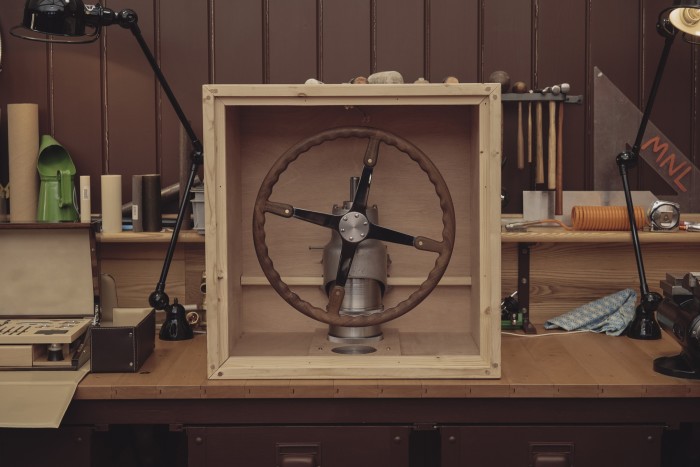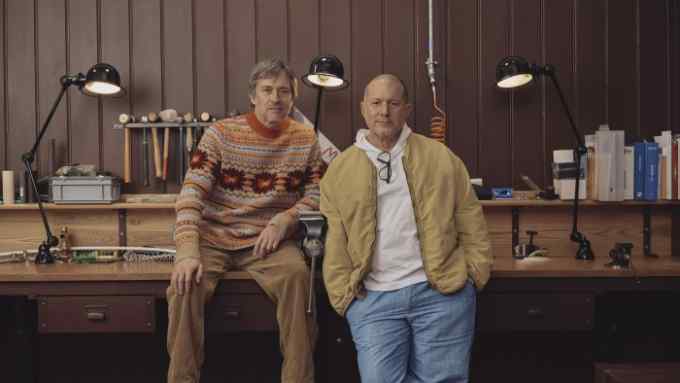‘It’s a head office for tinkering’: Jony Ive and Marc Newson talk tools

Roula Khalaf, Editor of the FT, selects her favourite stories in this weekly newsletter.
Marc Newson: When I bought this house, the first thing I renovated was my workshop and garage. It has been functioning for the past three years, but we only moved into the house this March.
Jony Ive: To be honest I would not have expected anything else! Looking around a space like this, I find it hard not to be happy. This is a fantastic metal workshop. My workshop is really for working in wood: just as I once made furniture with my father when I was a child, I’ve made furniture with my children in the workshop.
MN: I had to have a “head office” before a house, but it’s a head office for tinkering. I’m not really doing heavy, heavy machining. The workshop used to be a tack room and what was the stable is now a garage for my cars… so a different kind of stable, I guess.
JI: We have already spent a lot of time working together here. Your house is extraordinary and this is an area I’ve been in love with for many years. We bought a house on the same stretch of river, literally five minutes away. The opportunity to be this close is fabulous and means that when I am in the UK we can work together so easily – whether it’s our work with Apple or Ferrari.


MN: This is an appropriate place to work on an automotive project, because there are so many fantastic classic cars and people with car collections around here. [Pink Floyd drummer] Nick Mason is just up the road and his collection is amazing. The best Bugatti restorer is nearby, and the best Ferrari restorer too. There’s this incredible concentration of old cars in the area.
JI: I am really fascinated by old cars. I just drove over in a Bentley S2 Continental. It was made 60 years ago and was restored 20 years ago by P&A Wood in Essex. It is so beautiful on many levels. It reminded me of one of the things we were talking about recently. There was a time when we were able and motivated to maintain and look after products. Beyond just buying something, we were caring for it, which is obviously better than recycling.
MN: I was going to be a jeweller and a silversmith. I wasn’t particularly accomplished at either. But being a jeweller led to my interest in things like watches, which subsequently I designed a few of. As you said, it was all about making things: learning how to use tools and learning about materials, particularly types of metals, how to build things yourself. I didn’t have formal training as a designer so, when I started my career, learning how to make things was very much a means to an end. I didn’t know how to create something without physically making it. At the time I would have been happier getting someone else to do it, but growing up in Australia, manufacturing was not as sophisticated as perhaps in Europe. Even if it had been, it would have been beyond my means. Only later did I realise that as I was making things I was learning, learning all the time.


JI: My father was a silversmith and teacher. I think the most precious Christmas present I received from him was a day or two of his time in the workshop. There was an understanding that I had to spend time thinking about and drawing what I wanted to make. I didn’t really know it was called “design”. Growing up, it seemed a very natural thing to understand the physical world by understanding how it was made. Obviously everything in here was designed and made, and everything that is designed and made stands as testament to the values of the people behind it. I think it is interesting to understand an object in terms of how it came to be: not just the philosophy behind it, but how it was made. I think it is quite rare that people could even describe how the chair they sit on is actually made.
MN: I 100 per cent agree. Undertaking the process of renovating an old house, I can say without any shadow of a doubt that the skills needed to restore a Grade I-listed house are not non-existent, but they are dying.
JI: We’ve talked a lot about how making products in high volume obviously consumes enormous resources. I do think our understanding of the physical world, of materials and resources, is connected to our curiosity about how things come to be. As humans, we tend to be more responsible stewards of the things we truly understand. There were generations of children who left school knowing how to make, understanding the biography of our manufactured environment. If you have to make something, you end up with both a “thing” and more importantly a knowledge about materials and the architecture and construction of objects.
When I went to school, there was a broad commitment to facilities that would help you make. For reasons of cost, but I suspect primarily driven by classically educated members of government, there are now fewer workshops or spaces to create and make. 3D printing has a value but you don’t learn much from just pressing Cmd+P on a keyboard.


MN: I guess one of the very sad things is that you would really struggle now to learn from somebody how to use one of the machines in my workshop. People of your father’s generation certainly could have taught that; after all, that is what he did. But today, unless you can teach yourself how to use these things, it is very difficult.
JI: There’s a beauty and a joy in the machines and tools. They are no longer solely a means to an end. I think there’s an inherent elegance in an effective tool that normally results in a curious beauty. It is very sad to think that they are coming out of schools.
MN: That’s where that milling machine came from [Marc indicates a large green machine]. It’s called a Tom Senior. And the blue one is called a Myford Super 7. If you talk to anyone about lathes, they will tell you that the Myford Super 7 is the Rolls-Royce of lathes. Myford first made it in the early 1950s and it is still being made today. I couldn’t imagine my life without it. Since the age of about 22, when I was trying to be a jeweller and silversmith, I’ve never lived without a lathe.
JI: That’s a lovely thing to say. It is one of the things that is fundamental to the rigour of our collaborations. If you don’t know how to make something, and you go straight to defining form, it tends to be arbitrary. We are surrounded by products that were designed and modelled digitally, with little regard or understanding of their real, material attributes. If you don’t have personal and practical experience of a material – say, the difference between aluminium and titanium – it is hard to develop the right forms. And ultimately, while you cannot perhaps articulate why, sometimes objects just seem right. They seem simple, cohesive, almost inevitable...
MN: Or having had some experience and understanding of the difference between titanium and aluminium and steel and brass and copper; the difference between a ferrous and non-ferrous metal; the relevance of different melting points; and joining metals together, knowing the difference between soldering, brazing and welding…


JI: I do feel that these shared experiences and understanding characterise the way that we work together. I think that there is an effortlessness. That doesn’t mean that there isn’t a tremendous amount of effort… there is. It just seems so gentle, and uncontrived and unreached for… Maybe it is about our communication. You can flail around putting all your energy into trying to explain what you think; our energy is consumed by the idea, not trying to describe it.
I do think our work on the Apple Watch together speaks to a joyful and effective collaboration at a particularly difficult time. I had felt so strongly that there was an important opportunity to create a very personal and useful product that could be worn on the wrist. I spent a lot of time wrestling with the big founding ideas and the fundamental issues of interface but had somehow assumed that the work on the actual object would be fairly straightforward.
When the basic architecture of the idea was defined, I really struggled with the physical design. It was from that place of struggle that I asked you to help. While it was humbling for me, I think we got to the final design quickly together. We are proud of the work. I always hope to achieve that sense of inevitability, that simplicity where there doesn’t really appear to be a rational alternative. I know when we are working together we are trying to find the same design. I don’t know whether it’s just the combined experience. I don’t know whether it’s just the chemistry and the shared references. But it seems like a particularly precious and valuable place to be.
MN: It’s quite serendipitous. It’s effortless, subtle, spontaneous, natural and, I think most importantly, it’s fun. I suppose with any career or any job, something that you essentially do for a living, it can become mundane at times. I guess, on some level, we’re all struggling with that. But it’s nice when you can have some fun and things then evolve in a very organic and positive way.
JI: As well as being, as you say, more joyful and fun to work together, it is absurdly effective. That is essentially why we started LoveFrom, as a collective of creatives who enjoy working together. I love collaboration… clearly we’ve enjoyed the process enormously over so many years.
MN: And will continue to enjoy it – I hope – for many, many years to come.

Comments